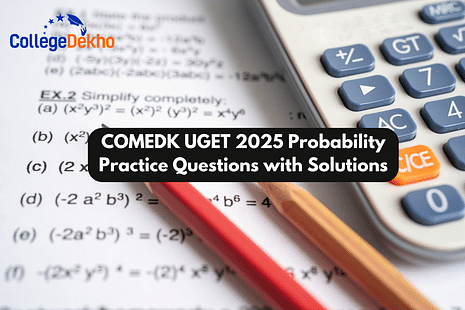
COMEDK UGET 2025 Probability Practice Questions with Solutions: Probability holds significant weightage in the COMEDK UGET syllabus. COMEDK UGET 2025 Probability practice questions include various essential topics, including Exhaustive events, Mutually exclusive events, Axiomatic (set theoretic) probability, and connections with previous theories from earlier classes. With an overall weightage of around 8%, this chapter is expected to have around 1-5 questions in the upcoming COMEDK UGET 2025 exam . Since the COMEDK UGET 2025 Mathematics syllabus covers topics from the 11th and 12th standards, it is strongly recommended to solve the COMEDK UGET Probability sample questions 2025 rather than revisiting all topics from scratch. This approach will help you become familiar with the exam pattern, question types, their weightage, and more. Practicing these questions will also help you identify commonly repeated questions in the exams. In this article, we will discuss the COMEDK UGET 2025 Probability practice questions with solutions, which can boost your chances of success in the examination.
Also Check -
Do or Die Chapters for COMEDK UGET 2025 Mathematics
Quick Links:
COMEDK UGET 2025 Probability Important Topics
COMEDK UGET 2025 Probability topic consists of several subtopics, including Axiomatic (set theoretic) probability, Connections with previous theories from earlier classes, Probability of an event, Probability of ‘not’, ‘and’, and ‘or’ events, among others. It is important to note that the COMEDK UGET question paper 2025 will feature questions based on these topics. Therefore, you should focus on these areas. Below is a list of COMEDK UGET 2025 Probability subtopics for exam preparation:-
Chapter | Topics |
|---|---|
Probability |
|
Also Check - COMEDK Chapter Wise PYQ for Mathematics
COMEDK UGET 2025 Probability Expected Weightage
As an aspirant, it is essential to be aware of the COMEDK Probability question weightage and the total number of questions that the chapter will carry. Understanding this will help you prepare more effectively. The table below provides a summary of the expected weightage of COMEDK UGET Probability along with the expected number of topics:-
Topic | Expected Number of Questions | Expected Weightage |
|---|---|---|
Probability | 1-5 | 1-8% |
Quick Links:
COMEDK UGET 2025 Probability Practice Questions with Solutions
Regularly practicing with COMEDK Probability sample questions can greatly improve your exam preparation. Solving COMEDK UGET 2025 Probability practice questions with solutions will help you become familiar with potential exam questions, confirm accurate answers, and understand step-by-step solutions. Below are some important COMEDK UGET Probability practice questions, carefully curated by experts from previous exam papers:-
Q1. While shuffling a pack of cards, 3 cards were accidentally dropped, then find the probability that the missing cards belong to different suits?
a) 104/425
b) 169/425
c) 261/425
d) 169/261
Correct answer: b) 169/425
Solution: Here's how to solve this probability problem:
1. Understanding the Problem
We have a standard deck of 52 cards with 4 suits (hearts, diamonds, clubs, spades), each having 13 cards. We're interested in the probability that the 3 dropped cards are from different suits.
2. Calculate the Total Possible Outcomes
The total number of ways to choose 3 cards from a deck of 52 is:
52 C 3 = 52!/3!49! = 22100
3. Calculate the Favorable Outcomes
To get 3 cards from different suits, we can think about the selection process:
First card: We can choose any card (52 possibilities).
Second card: To ensure it's from a different suit, we have only 39 cards left (52 total - 13 of the same suit).
Third card: To get a third suit, we have 26 cards remaining (52 total - 13 of the first suit - 13 of the second suit).
So, the number of ways to choose 3 cards from different suits is: 52 * 39 * 26. However, we've overcounted since the order we choose the cards doesn't matter (heart, diamond, club is the same as diamond, club, heart). We need to divide by 3! (3 factorial) to account for the different orderings.
Favorable Outcomes:
(52 x 39 x 26)/3! = 21972
4. Calculate the Probability
Probability = (Favorable Outcomes) / (Total Possible Outcomes)
Probability = 21972 / 22100 = 169/170
5. Simplifying and Matching Options
The probability 169/170 is not directly one of the options. However, we can see that 169/170 can be simplified by dividing both numerator and denominator by 170/261 = 169/425
Answer: The correct answer is Option B,
Q2. Suppose we have three cards identical in form except that both sides of the first card are coloured red, both sides of the second are coloured black, and one side of the third card is coloured red and the other side is coloured black. The three cards are mixed and a card is picked randomly. If the upper side of the chosen card is coloured red, what is the probability that the other side is coloured black.
a) 1/6
b) 1/2
c) 0
d) 1/3
Correct answer: d) 1/3
Solution: We have three cards with the following color configurations:
Card 1: Red on both sides.
Card 2: Black on both sides.
Card 3: Red on one side, Black on the other side.
If we pick a card at random and find that the upper side is red, we need to find the probability that the other side is black.
First, let's enumerate all possible sides of the cards:
Card 1: R, R
Card 2: B, B
Card 3: R, B
When a card is picked, any side is equally likely to be the upper side. Here are the possible outcomes where the upper side is red:
Upper side is Red, lower side is Red (Card 1, Side 1)
Upper side is Red, lower side is Red (Card 1, Side 2)
Upper side is Red, lower side is Black (Card 3, Side 1)
So, there are three possible favorable outcomes where the upper side is red. Now, we count how many of these favorable outcomes have black as the other side:
Card 1, Side 1: Other side is Red
Card 1, Side 2: Other side is Red
Card 3, Side 1: Other side is Black
Only one of these outcomes has the other side colored black. Therefore, the probability is:
Number of favorable outcomes with red upper side and black lower side/ Total number of favorable outcomes with red upper side = 1/3
Therefore, the correct answer is:
Option D
Q3. There are some baskets. The chances of picking a loaded basket and choosing a red coloured one is 0.2 . For every 100 tries to pick one basket, 60 times a basket is either loaded or red in colour. What is the probability of choosing an empty basket plus choosing not a red coloured one.
a) 1.2
b) 0.4
c) 1.3
d) 0.8
Correct answer: a) 1.2
Solution: Given:
Probability of picking a loaded basket AND choosing a red-colored one = P(A∩B)=0.2
For every 100 tries, a basket is either loaded OR red 60 times.
Probability of a basket being loaded OR red = P(A∪B)=60100=0.6
We need to find:
Probability of choosing an empty basket PLUS choosing not a red-colored one.
Using the formula for union of two events:
P(A∪B)=P(A)+P(B)−P(A∩B)
Given: P(A∪B)=0.6 and P (A∩B)=0.2
0.6=P(A)+P(B)−0.2
P(A)+P(B)=0.6+0.2=0.8
Now, we want to find:
P(A c )+P(B c )
Where:
P(A c ) = Probability of choosing an empty basket.
P(B c ) = Probability of not choosing a red-colored basket.
By the complement rule:
P(Ac)=1−P(A)
P(Bc)=1−P(B)
P(Ac)+P(Bc)=1−P(A)
=2−(P(A)+P(B))
=2−0.8=1.2=
Final Answer = 1.2
Q4. A determinant of the second order is made with elements 0 and 1. What is the probability that the determinant made is non-negative?
a) 11/16
b) 7/16
c) 3/16
d) 13/16
Correct answer: d) 13/16
Q5. The probability that a randomly chosen number from one to twelve is a divisor of twelve is:
a) 5/12
b) 1/3
c) 5/6
d) 1/2
Correct answer: d) 1/2
Solution: To determine the probability that a randomly chosen number from one to twelve is a divisor of twelve, we first need to identify all the divisors of twelve. A divisor of twelve is any number that divides twelve without leaving a remainder.
The divisors of twelve are: 1, 2, 3, 4, 6, 12
There are a total of six divisors of twelve.
Next, we note that the total number of possible choices (from one to twelve) is twelve.
The probability P that a randomly chosen number from one to twelve is a divisor of twelve is given by the ratio of the number of favorable outcomes (divisors) to the total number of possible outcomes:
P = Number of divisors of 12/ Total number of choices = 6/12 = 1/2
Therefore, the correct answer is Option D:
Option D
Related Articles
Are you feeling lost and unsure about what career path to take after completing 12th standard?
Say goodbye to confusion and hello to a bright future!

Was this article helpful?





















Similar Articles
GATE CS Question Paper Difficulty Level Trends: A detailed analysis
JEE Main 2026 Chemistry High Priority and Low Priority Chapters
Are JEE Main Study Groups Worth It? Detailed Pros and Cons for 2026 Aspirants
How to Prioritize Physics Chapters Based on JEE Main 2026 Weightage and Difficulty
GATE 2026 Mechanical Engineering Expected No. of Questions Topic-Wise
GATE 2026 Civil Engineering Expected No. of Questions Topic-Wise